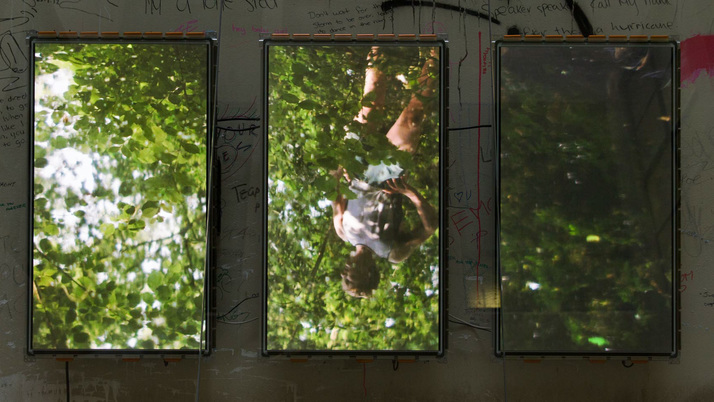-
From Current Issue
-
- Editor’s Letter Fire in the Heart
- Reviews I Gusti Ayu Kadek Murniasih
- Reviews 11th Seoul Mediacity Biennale: “One Escape at a Time”
- Dispatch Networked China
- One on One Monira Al Qadiri on Yukio Mishima
- Essays The rise of independent art spaces in pandemic-era Shanghai
- Features Tuan Andrew Nguyen
- Table of Contents
- Web Exclusives
- Archive
- Subscribe

R
E
V N
E
X
T
Installation view of TRENT CRAWFORD and STANTON CORNISH-WARD’s LOCK, 2021, three-channel video installation, sound, tempered glass, aluminum, at Discordia, Melbourne, 2021. All images courtesy Discordia.
The Empty Promise of Salvation: Trent Crawford and Stanton Cornish-Ward’s “LOCK”
Outside in Discordia Gallery’s central courtyard, Trent Crawford and Stanton Cornish-Ward’s three-channel CGI video LOCK (2021) was installed across three vertical screens under a well-disguised glass awning. The courtyard itself was covered in graffiti tags and permanent marker scrawl. One phrase read “don’t wait for the storm to be over, learn to dance in the rain,” a cliché that captures LOCK’s focus on self-help and multi-level marketing.
Akin to a late-night new-age infomercial shilling enlightenment or a lingering YouTube advert teasing the secrets to leading an optimized life, LOCK offers three soliloquies, with each narrator recounting their escape from the harsh realities of contemporary existence and their path to a heightened state of being known as Lock. Although ostensibly leading divergent lives in different places, the trio are tethered together through their shared traumatic experiences and discovery of Lock.
The first account is delivered by a young woman with a soft Eastern European accent. She recounts vivid moments from childhood of her great-grandmother: helping her cook, lounging in her garden, sitting quietly in her living room, attending her funeral. The second narration is another young woman, this time with a generic North American inflection who relates her time as a sales associate in an upscale boutique located in one of the city’s most expensive boroughs. Her life is marred by a harrowing attack involving an “incel” who motored down female pedestrians before ultimately crashing into the shopfront and shooting a customer right in front of the narrator.
The most lucid vignette is the final account, given by a middle-aged man with a thick Australian drawl. Suffering two dissociative episodes, one lasting a few months in 2001 and the other nearing a full year between 2003 and 2004, he recounts feelings of emptiness and a loss of self. Fifteen years later he abandons his wife and children, insisting that “by stepping away we force others to wake up to the world in our absence.”
Each monologue is accompanied by loosely corresponding footage: banal b-roll, archival clips, and stock footage are stitched together with imagery of virtually rendered people. These characters are deepfakes, generated by feeding an AI data sets of found footage. Generic-looking young women pop up intermittently over the course of the first two storylines, followed by an older man in the final segment. Yet the connection between the footage shown and the voices heard is arbitrary; each virtual actor is an avatar for the anonymous people behind each tale, yet we do not see these digital marionettes speak. Meanwhile, Lock is never shown as a concrete form but is instead represented by generic footage of the natural sublime: sunsets, tree canopies, wheat fields, starry skies, and the like.
LOCK is an unsettling film, situated in the uncanny valley where the deepfake AIs are clearly synthetic yet almost tangible, capable of posturing as anyone yet simultaneously being no one. More sinister is how familiar each narrative is: a death in the family, witnessing a horrific crime, suffering from bouts of intense mental illness. The multi-trillion-dollar industry of self-help and optimization feels relevant here, offering a salve in everything from essential oils sold via pyramid schemes to self-care webinars to quasi-spiritual cults cosplaying as an alternative to religion.
Crawford and Cornish-Ward’s film leans into the tropes of this very industry. The trio of non-human actors produce unwavering, persuasive spiels in the dulcet tones of TED Talk experts, bitcoin gurus, and cult leaders. As in these genres of media, the content of the narrators’ words are not as important as their charismatic delivery, which sells the enlightening Lock as yet another product. What LOCK revels in is the complete emptiness of the marketed image, and by extension probes what this might be doing to our subjecthood and (in)ability to create meaning in our own lives. In this world, human subjects are just as empty as the images flickering in front of us. Trauma is emptied, untethered from the suffering of an individual body or mind, and reshaped into a marketer’s promise that you, too, can find meaning through Lock.
Stanton Cornish-Ward and Trent Crawford’s “LOCK” is on view at Discordia, Melbourne, until September 11, 2021.
To read more of ArtAsiaPacific’s articles, visit our Digital Library.













